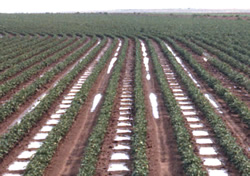This page has been archived and is being provided for reference purposes only. The page is no longer being updated, and therefore, links on the page may be invalid.
|
Adapting Furrow Dikes for Southeast U.S. Farming
By Sharon DurhamSeptember 20, 2005
Furrow dikes may lead to greater absorption of water and reduced runoff during rain events, resulting in more water becoming available for crop use, according to preliminary data from Agricultural Research Service (ARS) scientists. Furrow dikes are small basins formed in loosened soil between crop rows.
Agronomist Russell Nuti of the ARS National Peanut Research Laboratory (NPRL) in Dawson, Ga., found that even in a wet growing season, the use of furrow dikes resulted in enhanced water infiltration and better maintenance of soil moisture.
Furrow diking is commonly used by farmers in the arid regions of the western and northwestern United States, when growing crops such as cotton, grain sorghum and potatoes.
Nuti is adapting furrow diking to accommodate the sloping crop sites often found in the southeastern states, where peanuts, cotton and corn are often grown. Slopes in the topography often lead to quick water runoff and ponding at lower elevations. Capture of more rainfall by furrow dikes could improve yield stability in non-irrigated cropping systems.
The data will be added to the In-Season Cost Monitoring and Irrigation Scheduling System called FarmSuite that was developed by NPRL researchers. This software package is used by many growers to monitor all crop production inputs, from initial tillage operations to final crop harvest. Previous research has demonstrated that using expert systems software increases confidence in making farm management decisions by 91 percent by providing precise, timely recommendations based on current technology and scientific data.
ARS is the U.S. Department of Agriculture's chief in-house scientific research agency.

